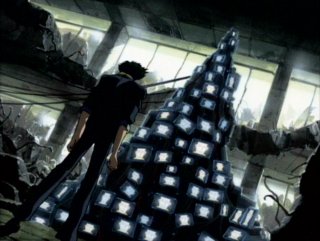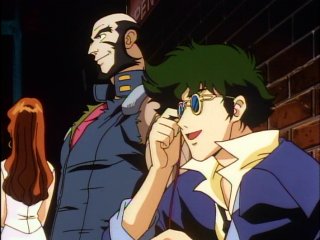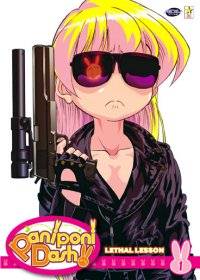After a few weeks and various obstacles (work, Netflix), I have finally completed Martian Successor Nadesico. Overall, I’m happy with it, though there are a few things about the series that I didn’t particularly care for. Many of my initial thoughts still hold. For instance, I couldn’t stop noticing the similarities between this series and Vandread (and Vandread: Second Stage), though towards the end, things did seem to be a little less Vandread-like.
The series takes place a few hundred years in the future. Humans have colonized the Moon and Mars, but attackers from Jupiter start to cause lots of trouble on Mars. The Jovian Lizards are seemingly unstoppable, but a privately built warship developed by Nergal industries gives hope to humanity. Commanded by the ditsy but competant Yurika, the Nadesico and her crew, including reluctant pilot Akito, take on their Jovian enemy. But everything is not what it seems.

The Nadesico
Again, the similarities to Vandread are more than skin deep (though I should note that Vandread was produced after Nadesico). All the major elements are there – a mysterious enemy with overpowering technology and automated attack ships, a male pilot with a mysterious past who is pursued by several jealous females, a ship’s computer that’s a living entity of some kind, etc… There’s even some strange male/female issues going on (though nothing as explicit as Vandread‘s war between men and women). The list goes on and on and on. Sure, there are some wrinkles in the various formulas, but overall the series are quite similar. However, the impression I’m getting is that both series are simply drawing from a larger pool of clichés that feature prominently in other series about mechas and space combat. Nadesico has more of a referential tone than Vandread though, and it seems to approach parody or even farce at times. It breaks the fourth wall often (once, a character even tells another character that she’s breaking the fourth wall) and it often seems to be poking fun at itself. As someone who isn’t especially familiar with the genres in question, I can’t be sure just how well Nadesico captures and skewers the genres, but I enjoyed it even without that context.
While the series does have the aformentioned lighthearted tone, it’s not always like that. It often veers off into more serious territory, and from the very beginning of the series, the creators never let you forget that this is a war. There are several surprises strewn throughout. Betrayals and death are not shyed away from, even as the series constantly pokes fun at itself. To be honest, I’m not sure how well they pulled this off. There aren’t many big switches between silly fun and deadly earnestness, but when they happen, it’s quite disorienting. Some episodes are just so silly (like perhaps episode 19, the Nadesico Idol episode) that it’s hard to believe that other episodes are from the same series. This inconsistent tone is odd, though not necessarily a bad thing (and the same inconsistency struck me about Vandread as well, so perhaps it’s not so unusual).
One thing about this series that I really liked was that they did try some interesting things. Results vary, but when they take a risk and it works, the results are great. Some of the episodes really stood out, particularly the Run Silent, Run Deep episode. It’s the 20th episode in the series, and it features a battle of wits between the captain of the Nadesico and an enemy captain that’s reminiscent of the classic submarine movies like The Enemy Below and, uh, well… Run Silent Run Deep. The enemy has developed a new and potentially devestating weapon, and the Nadesico must run for it’s life… Eventually, they mount a creative counter attack. What makes this work is that both sides are competent, their tactics sound, and you can tell there’s a respect between them. It was an enthralling episode and I’ve already watched it twice.
Most of the main characters are reasonably well defined and interesting. The main character of the series is Akito, a cook and reluctant pilot who has a mysterious past on Mars and is troubled by his role in the war. He’s also pursued by several female members of the crew (and other women throughout the series). This harem comedy thing sometimes works, but this series goes a little overboard with it.
Visually, the series well done but not spectacular. As I mentioned before, the subtitles were a little hard to read at times (They use different colors to indicate background speech and foreground speech, but they’re sometimes inconsistent with it and in a couple of cases, the text takes up more than half the screen!) so I mostly watched the dubbed version. I’m not a huge fan of the music in the series, but by the end, I’d gotten used to it.
The end of the series is somewhat satisfying. The main character arc of Akito and Yurika is resolved, but a lot of subplots are left open or unexplored. Apparently, there’s a movie that continues the story, but from what I can see, even that doesn’t finish the story.
More comments and screenshots below the fold…
…
Martian Successor NadesicoRead More »





